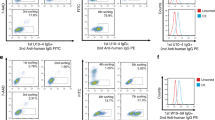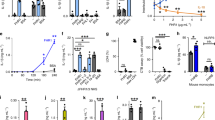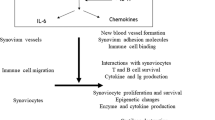Abstract
How certain autoimmune diseases target specific organs remains obscure. In the 'K/BxN' arthritis model, autoantibodies to a ubiquitous antigen elicit joint-restricted pathology. Here we have used intravital imaging to demonstrate that transfer of arthritogenic antibodies caused macromolecular vasopermeability localized to sites destined to develop arthritis, augmenting its severity. Vasopermeability depended on mast cells, neutrophils and FcγRIII but not complement, tumor necrosis factor or interleukin 1. Unexpectedly, radioresistant FcRγ-expressing cells in an organ distant from the joint were required. Histamine and serotonin were critical, and systemic administration of these vasoactive amines recapitulated the joint localization of immune complex–triggered vasopermeability. We propose that regionally distinct vascular properties 'interface' with immune effector pathways to foster organ-specific autoimmune damage, perhaps explaining why arthritis accompanies many human infectious and autoimmune disorders.
* Note: In the version of this article initially published online, the end of the third sentence of the second subsection of Results is incorrect. The sentence should read “Intravenous administration of preaggregated normal mouse IgG elicited an increase in joint-localized vasopermeability very similar to that induced by the administration of arthritogenic serum (Fig. 2b and data not shown).” Also, the final acknowledgement is incorrect; it should read “… and by the National Institute of Diabetes and Digestive and Kidney Diseases–supported Diabetes and Endocrinology Research Center cores of the Joslin Diabetes Center.” The errors have been corrected for the HTML and print versions of the article.
This is a preview of subscription content, access via your institution
Access options
Subscribe to this journal
Receive 12 print issues and online access
$209.00 per year
only $17.42 per issue
Buy this article
- Purchase on Springer Link
- Instant access to full article PDF
Prices may be subject to local taxes which are calculated during checkout






Similar content being viewed by others
Change history
07 February 2006
In the version of this article initially published online, the end of the third sentence of the second subsection of Results is incorrect. The sentence should read “Intravenous administration of preaggregated normal mouse IgG elicited an increase in joint-localized vasopermeability very similar to that induced by the administration of arthritogenic serum (Fig. 2b and data not shown).” Also, the final acknowledgement is incorrect; it should read “… and by the National Institute of Diabetes and Digestive and Kidney Diseases–supported Diabetes and Endocrinology Research Center cores of the Joslin Diabetes Center.” The errors have been corrected for the HTML and print versions of the article.
References
Kouskoff, V. et al. Organ-specific disease provoked by systemic autoreactivity. Cell 87, 811–822 (1996).
Oono, T. et al. Organ-specific autoimmunity in mice whose T cell repertoire is shaped by a single antigenic peptide. J. Clin. Invest. 108, 1589–1596 (2001).
Kowal, C. et al. Cognition and immunity; antibody impairs memory. Immunity 21, 179–188 (2004).
Matsumoto, I., Staub, A., Benoist, C. & Mathis, D. Arthritis provoked by linked T and B cell recognition of a glycolytic enzyme. Science 286, 1732–1735 (1999).
Korganow, A.-S. et al. From systemic T cell self-reactivity to organ-specific autoimmune disease via immunoglobulins. Immunity 10, 451–461 (1999).
Maccioni, M. et al. Arthritogenic monoclonal antibodies from K/BxN mice. J. Exp. Med. 195, 1071–1077 (2002).
Ji, H. et al. Arthritis critically dependent on innate immune system players. Immunity 16, 157–168 (2002).
Ji, H. et al. Critical roles for interleukin-1 and tumor necrosis factor-α in antibody-induced arthritis. J. Exp. Med. 196, 77–85 (2002).
Wipke, B.T. & Allen, P.M. Essential role of neutrophils in the initiation and progression of a murine model of rheumatoid arthritis. J. Immunol. 167, 1601–1608 (2001).
Lee, D.M. et al. Mast cells: a cellular link between autoantibodies and inflammatory arthritis. Science 297, 1689–1692 (2002).
Corr, M. & Crain, B. The role of FcγR signaling in the K/B x N serum transfer model of arthritis. J. Immunol. 169, 6604–6609 (2002).
Matsumoto, I. et al. How antibodies to a ubiquitous cytoplasmic enzyme may provoke joint-specific autoimmune disease. Nat. Immunol. 3, 360–365 (2002).
Mangialaio, S., Staub, A., Benoist, C. & Mathis, D. The arthritogenic T cell receptor and its ligand in a spontaneous model of arthritis. Arthritis Rheum. 42, 2517–2523 (1999).
Pober, J.S. & Cotran, R.S. The role of endothelial cells in inflammation. Transplantation 50, 537–544 (1990).
Weissleder, R., Bogdanov, A., Tung, C.H., Jr. & Weinmann, H.J. Size optimization of synthetic graft copolymers for in vivo angiogenesis imaging. Bioconjug. Chem. 12, 213–219 (2001).
Akilesh, S. et al. The MHC class I-like Fc receptor promotes humorally mediated autoimmune disease. J. Clin. Invest. 113, 1328–1333 (2004).
Lovdal, T., Andersen, E., Brech, A. & Berg, T. Fc receptor mediated endocytosis of small soluble immunoglobulin G immune complexes in Kupffer and endothelial cells from rat liver. J. Cell Sci. 113, 3255–3266 (2000).
Benjamim, C.F., Canetti, C., Cunha, F.Q., Kunkel, S.L. & Peters-Golden, M. Opposing and hierarchical roles of leukotrienes in local innate immune versus vascular responses in a model of sepsis. J. Immunol. 174, 1616–1620 (2005).
Wipke, B.T., Wang, Z., Kim, J., McCarthy, T.J. & Allen, P.M. Dynamic visualization of a joint-specific autoimmune response through positron emission tomography. Nat. Immunol. 3, 366–372 (2002).
Wipke, B.T., Wang, Z., Nagengast, W., Reichert, D.E. & Allen, P.M. Staging the initiation of autoantibody-induced arthritis: a critical role for immune complexes. J. Immunol. 172, 7694–7702 (2004).
Lovdal, T. & Berg, T. Transcription of Fcγ receptors in different rat liver cells. Cell Biol. Int. 25, 821–824 (2001).
Kitamura, Y., Shimada, M., Hatanaka, K. & Miyano, Y. Development of mast cells from grafted bone marrow cells in irradiated mice. Nature 268, 442–443 (1977).
Theoharides, T.C., Bondy, P.K., Tsakalos, N.D. & Askenase, P.W. Differential release of serotonin and histamine from mast cells. Nature 297, 229–231 (1982).
Moriyama, M. et al. The neuropeptide neuromedin U promotes inflammation by direct activation of mast cells. J. Exp. Med. 202, 217–224 (2005).
Majno, G. & Palade, G.E. Studies on inflammation. 1. The effect of histamine and serotonin on vascular permeability: an electron microscopic study. J. Biophys. Biochem. Cytol. 11, 571–605 (1961).
Majno, G. et al. A pancreatic venular defect in the BB/Wor rat. Am. J. Pathol. 128, 210–215 (1987).
Knight, A.D. & Levick, J.R. Morphometry of the ultrastructure of the blood-joint barrier in the rabbit knee. Q. J. Exp. Physiol. 69, 271–288 (1984).
Sylvestre, D.L. & Ravetech, J.V. A dominant role for mast cell Fc receptors in the Arthus reaction. Immunity 5, 387–390 (1996).
Hopken, U.E., Lu, B., Gerard, N.P. & Gerard, C. Impaired inflammatory responses in the reverse Arthus reaction through genetic deletion of the C5a receptor. J. Exp. Med. 186, 749–756 (1997).
Baumann, U. et al. Distinct tissue site-specific requirements of mast cells and complement components C3/C5a receptor in IgG immune complex-induced injury of skin and lung. J. Immunol. 167, 1022–1027 (2001).
Hayashi, H., Yoshinaga, M., Koono, M., Miyoshi, H. & Matsumura, M. Endogeneous permeability factors and their inhibitors affecting vascular permeability in cutaneous Arthus reactions and thermal injury. Br. J. Exp. Pathol. 45, 419–435 (1964).
Ramos, B.F., Zhang, Y., Angkachatchai, V. & Jakschik, B.A. Mast cell mediators regulate vascular permeability changes in Arthus reaction. J. Pharmacol. Exp. Ther. 262, 559–565 (1992).
Miyajima, I. et al. Systemic anaphylaxis in the mouse can be mediated largely through IgG1 and FcγRIII. Assessment of the cardiopulmonary changes, mast cell degranulation, and death associated with active or IgE- or IgG1-dependent passive anaphylaxis. J. Clin. Invest. 99, 901–914 (1997).
Strait, R.T., Morris, S.C., Yang, M., Qu, X.W. & Finkelman, F.D. Pathways of anaphylaxis in the mouse. J. Allergy Clin. Immunol. 109, 658–668 (2002).
Finkelman, F.D., Rothenberg, M.E., Brandt, E.B., Morris, S.C. & Strait, R.T. Molecular mechanisms of anaphylaxis: lessons from studies with murine models. J. Allergy Clin. Immunol. 115, 449–457 (2005).
Geba, G.P. et al. Delayed-type hypersensitivity in mast cell-deficient mice: dependence on platelets for expression of contact sensitivity. J. Immunol. 157, 557–565 (1996).
Harbuz, M.S. et al. The role of endogenous serotonin in adjuvant-induced arthritis in the rat. Br. J. Rheumatol. 35, 112–116 (1996).
Yu, P. et al. Autoimmunity and inflammation due to a gain-of-function mutation in phospholipase Cγ2 that specifically increases external Ca2+ entry. Immunity 22, 451–465 (2005).
Horai, R. et al. Development of chronic inflammatory arthropathy resembling rheumatoid arthritis in interleukin 1 receptor antagonist-deficient mice. J. Exp. Med. 191, 313–320 (2000).
Hang, L., Theofilopoulos, A.N. & Dixon, F.J. A spontaneous rheumatoid arthritis-like disease in MRL/l mice. J. Exp. Med. 155, 1690–1701 (1982).
Sakaguchi, N. et al. Altered thymic T-cell selection due to a mutation of the ZAP-70 gene causes autoimmune arthritis in mice. Nature 426, 454–460 (2003).
Takai, T., Li, M., Sylvestre, D., Clynes, R. & Ravetch, J.V. FcRγ chain deletion results in pleitrophic effector cell defects. Cell 76, 519–529 (1994).
Roopenian, D.C. et al. The MHC class I-like IgG receptor controls perinatal IgG transport, IgG homeostasis, and fate of IgG-Fc-coupled drugs. J. Immunol. 170, 3528–3533 (2003).
Dombrowicz, D., Flamand, V., Brigman, K.K., Koller, B.H. & Kinet, J.P. Abolition of anaphylaxis by targeted disruption of the high affinity immunoglobulin E receptor α chain gene. Cell 75, 969–976 (1993).
Goulet, J.L., Snouwaert, J.N., Latour, A.M., Coffman, T.M. & Koller, B.H. Altered inflammatory responses in leukotriene-deficient mice. Proc. Natl. Acad. Sci. USA 91, 12852–12856 (1994).
Tager, A.M. et al. BLTR mediates leukotriene B4-induced chemotaxis and adhesion and plays a dominant role in eosinophil accumulation in a murine model of peritonitis. J. Exp. Med. 192, 439–446 (2000).
Hock, H. et al. Intrinsic requirement for zinc finger transcription factor Gfi-1 in neutrophil differentiation. Immunity 18, 109–120 (2003).
Katz, H.R. et al. Secretory granule mediator release and generation of oxidative metabolites of arachidonic acid via Fc-IgG receptor bridging in mouse mast cells. J. Immunol. 148, 868–871 (1992).
Huang, Q. et al. Noninvasive visualization of tumors in rodent dorsal skin window chambers. Nat. Biotechnol. 17, 1033–1035 (1999).
Acknowledgements
We thank V. Tran for assistance with serum collection; R. Melamed for software programming; N. Mathis for assistance with some of the experiments; L. Kozinn for assistance with manuscript preparation; and G. King for comments about the manuscript. Supported by the National Institutes of Health (PO1 AI54904 to C.B., D.M., R.W. and U.M.; RO1 AR046580 to D.M. and C.B.; and P50 CA86355, R24 CA92782 and R33 CA91007to R.W.), a Pfizer Postdoctoral Fellowship in Rheumatology/Immunology (B.B.) and by the National Institute of Diabetes and Digestive and Kidney Diseases–supported Diabetes and Endocrinology Research Center cores of the Joslin Diabetes Center.
Author information
Authors and Affiliations
Corresponding authors
Ethics declarations
Competing interests
U.M. is a consultant for and owns stock in VisEn Medical; R.W. is a cofounder of and owns stock in VisEn Medical.
Supplementary information
Supplementary Fig. 1
Calculation of maximum rate of leak and duration at half-maximum. (PDF 302 kb)
Supplementary Fig. 2
IgG subtype-specificity of immune complex triggered vasopermeability. (PDF 265 kb)
Supplementary Fig. 3
Effect of portal ligation on plasma histamine concentrations. (PDF 160 kb)
Supplementary Fig. 4
Proposed Model. (PDF 219 kb)
Supplementary Video 1
Vascular leak in the hindpaws following administration of K/BxN serum. Angiosense 680 was injected iv into a B6 mouse. Confocal micrographs of a hindpaw taken every 3 s for 10 min following injection of 200 μl of K/BxN arthritogenic serum were compressed into a video to demonstrate the dynamic nature of the vascular response. (MOV 1985 kb)
Rights and permissions
About this article
Cite this article
Binstadt, B., Patel, P., Alencar, H. et al. Particularities of the vasculature can promote the organ specificity of autoimmune attack. Nat Immunol 7, 284–292 (2006). https://doi.org/10.1038/ni1306
Received:
Accepted:
Published:
Issue Date:
DOI: https://doi.org/10.1038/ni1306
This article is cited by
-
Visualization of autoantibodies and neutrophils in vivo identifies novel checkpoints in autoantibody-induced tissue injury
Scientific Reports (2020)
-
Why location matters — site-specific factors in rheumatic diseases
Nature Reviews Rheumatology (2017)
-
Pre-symptomatic autoimmunity in rheumatoid arthritis: when does the disease start?
Seminars in Immunopathology (2017)
-
Myeloid Populations in Systemic Autoimmune Diseases
Clinical Reviews in Allergy & Immunology (2017)
-
CD4+ T cell anergy prevents autoimmunity and generates regulatory T cell precursors
Nature Immunology (2016)



